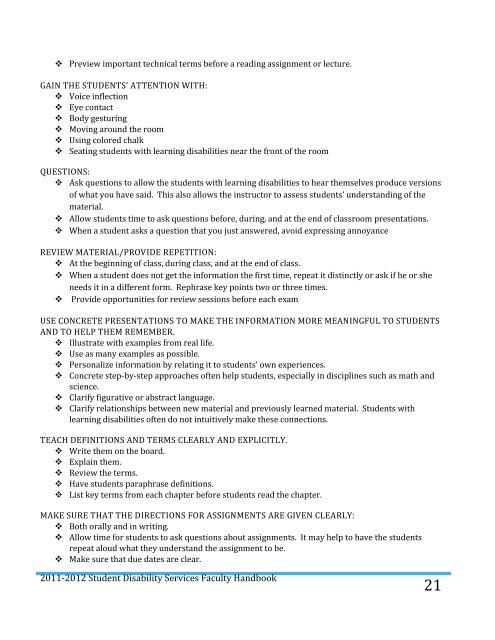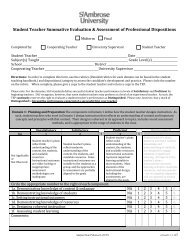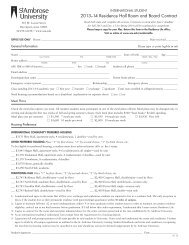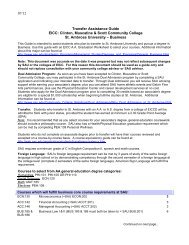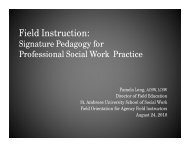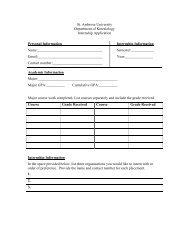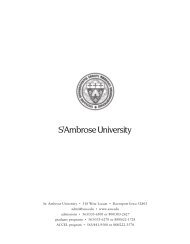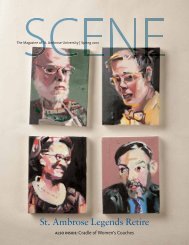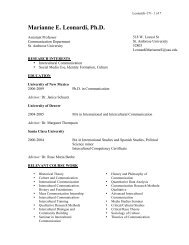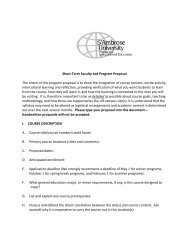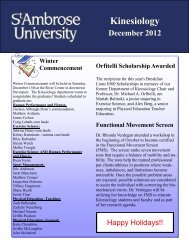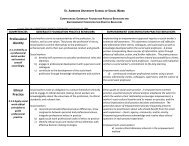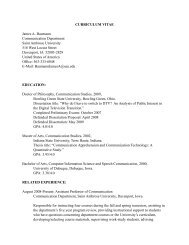student disability services faculty handbook - St. Ambrose University
student disability services faculty handbook - St. Ambrose University
student disability services faculty handbook - St. Ambrose University
Create successful ePaper yourself
Turn your PDF publications into a flip-book with our unique Google optimized e-Paper software.
Preview important technical terms before a reading assignment or lecture.<br />
GAIN THE STUDENTS’ ATTENTION WITH:<br />
Voice inflection<br />
Eye contact<br />
Body gesturing<br />
Moving around the room<br />
Using colored chalk<br />
Seating <strong>student</strong>s with learning disabilities near the front of the room<br />
QUESTIONS:<br />
Ask questions to allow the <strong>student</strong>s with learning disabilities to hear themselves produce versions<br />
of what you have said. This also allows the instructor to assess <strong>student</strong>s’ understanding of the<br />
material.<br />
Allow <strong>student</strong>s time to ask questions before, during, and at the end of classroom presentations.<br />
When a <strong>student</strong> asks a question that you just answered, avoid expressing annoyance<br />
REVIEW MATERIAL/PROVIDE REPETITION:<br />
At the beginning of class, during class, and at the end of class.<br />
When a <strong>student</strong> does not get the information the first time, repeat it distinctly or ask if he or she<br />
needs it in a different form. Rephrase key points two or three times.<br />
Provide opportunities for review sessions before each exam<br />
USE CONCRETE PRESENTATIONS TO MAKE THE INFORMATION MORE MEANINGFUL TO STUDENTS<br />
AND TO HELP THEM REMEMBER.<br />
Illustrate with examples from real life.<br />
Use as many examples as possible.<br />
Personalize information by relating it to <strong>student</strong>s’ own experiences.<br />
Concrete step-by-step approaches often help <strong>student</strong>s, especially in disciplines such as math and<br />
science.<br />
Clarify figurative or abstract language.<br />
Clarify relationships between new material and previously learned material. <strong>St</strong>udents with<br />
learning disabilities often do not intuitively make these connections.<br />
TEACH DEFINITIONS AND TERMS CLEARLY AND EXPLICITLY.<br />
Write them on the board.<br />
Explain them.<br />
Review the terms.<br />
Have <strong>student</strong>s paraphrase definitions.<br />
List key terms from each chapter before <strong>student</strong>s read the chapter.<br />
MAKE SURE THAT THE DIRECTIONS FOR ASSIGNMENTS ARE GIVEN CLEARLY:<br />
Both orally and in writing.<br />
Allow time for <strong>student</strong>s to ask questions about assignments. It may help to have the <strong>student</strong>s<br />
repeat aloud what they understand the assignment to be.<br />
Make sure that due dates are clear.<br />
2011-2012 <strong>St</strong>udent Disability Services Faculty Handbook<br />
21


